BMW X5 3.0I 2004 E53 Owner's Guide
Manufacturer: BMW, Model Year: 2004, Model line: X5 3.0I, Model: BMW X5 3.0I 2004 E53Pages: 200, PDF Size: 3.91 MB
Page 21 of 200
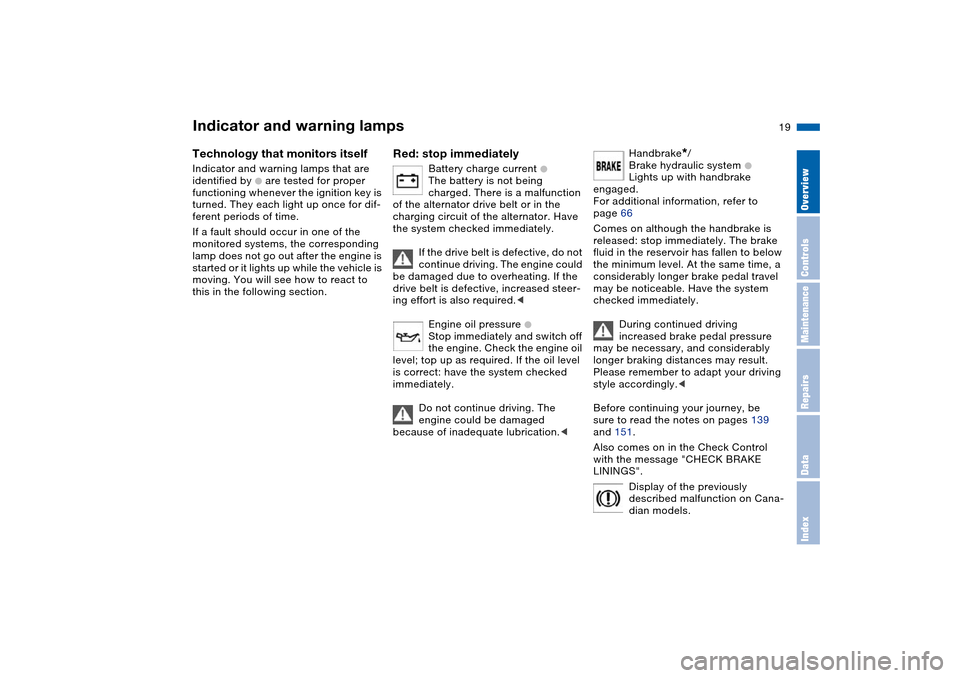
19n
OverviewControlsMaintenanceRepairsDataIndex
Indicator and warning lamps
Technology that monitors itself
Indicator and warning lamps that are
identified by
+
are tested for proper
functioning whenever the ignition key is
turned. They each light up once for dif-
ferent periods of time.
If a fault should occur in one of the
monitored systems, the corresponding
lamp does not go out after the engine is
started or it lights up while the vehicle is
moving. You will see how to react to
this in the following section.
Red: stop immediately
Battery charge current
+
The battery is not being
charged. There is a malfunction
of the alternator drive belt or in the
charging circuit of the alternator. Have
the system checked immediately.
If the drive belt is defective, do not
continue driving. The engine could
be damaged due to overheating. If the
drive belt is defective, increased steer-
ing effort is also required.<
Engine oil pressure +
Stop immediately and switch off
the engine. Check the engine oil
level; top up as required. If the oil level
is correct: have the system checked
immediately.
Do not continue driving. The
engine could be damaged
because of inadequate lubrication.<
Handbrake
*
/
Brake hydraulic system
+
Lights up with handbrake
engaged.
For additional information, refer to
page 66
Comes on although the handbrake is
released: stop immediately. The brake
fluid in the reservoir has fallen to below
the minimum level. At the same time, a
considerably longer brake pedal travel
may be noticeable. Have the system
checked immediately.
During continued driving
increased brake pedal pressure
may be necessary, and considerably
longer braking distances may result.
Please remember to adapt your driving
style accordingly.<
Before continuing your journey, be
sure to read the notes on pages 139
and 151.
Also comes on in the Check Control
with the message "CHECK BRAKE
LININGS".
Display of the previously
described malfunction on Cana-
dian models.
Page 22 of 200
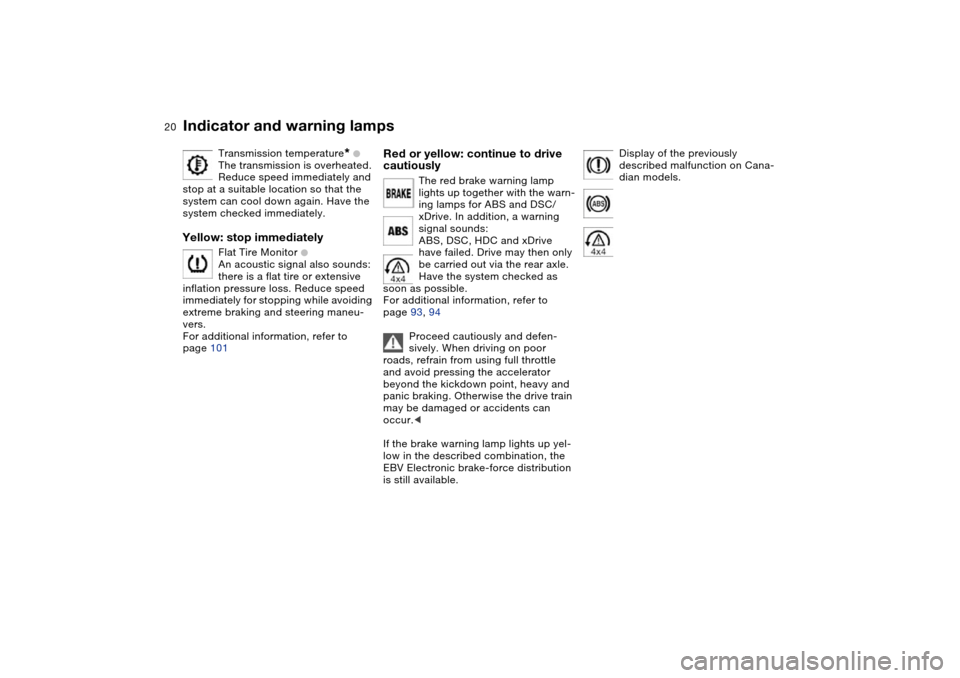
20n
Indicator and warning lamps
Transmission temperature
*
+
The transmission is overheated.
Reduce speed immediately and
stop at a suitable location so that the
system can cool down again. Have the
system checked immediately.
Yellow: stop immediately
Flat Tire Monitor
+
An acoustic signal also sounds:
there is a flat tire or extensive
inflation pressure loss. Reduce speed
immediately for stopping while avoiding
extreme braking and steering maneu-
vers.
For additional information, refer to
page 101
Red or yellow: continue to drive
cautiously
The red brake warning lamp
lights up together with the warn-
ing lamps for ABS and DSC/
xDrive. In addition, a warning
signal sounds:
ABS, DSC, HDC and xDrive
have failed. Drive may then only
be carried out via the rear axle.
Have the system checked as
soon as possible.
For additional information, refer to
page 93, 94
Proceed cautiously and defen-
sively. When driving on poor
roads, refrain from using full throttle
and avoid pressing the accelerator
beyond the kickdown point, heavy and
panic braking. Otherwise the drive train
may be damaged or accidents can
occur.<
If the brake warning lamp lights up yel-
low in the described combination, the
EBV Electronic brake-force distribution
is still available.
Display of the previously
described malfunction on Cana-
dian models.
Page 23 of 200
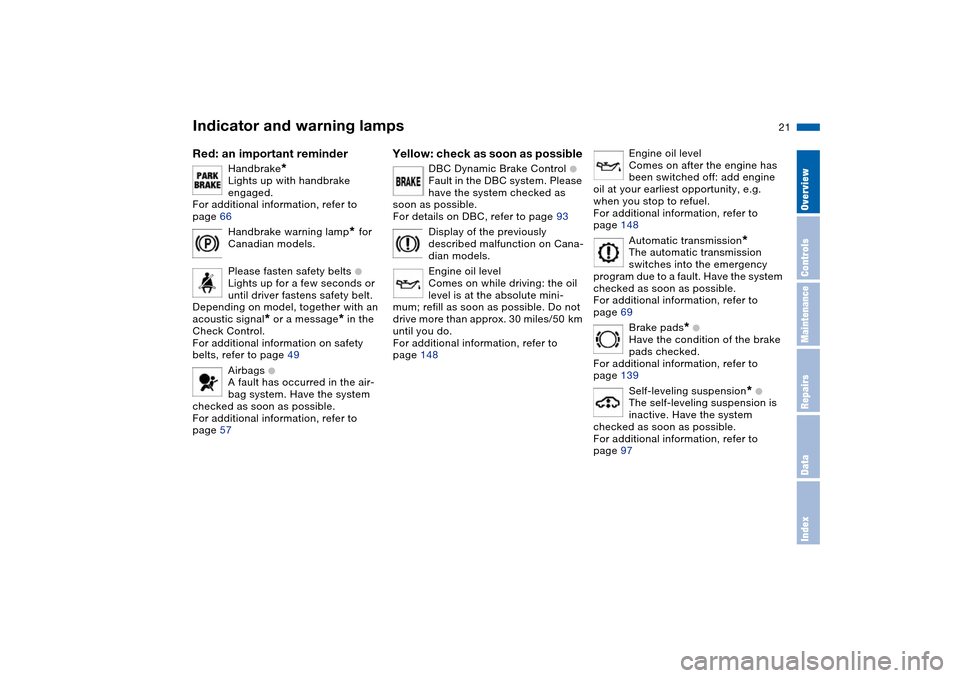
21n
OverviewControlsMaintenanceRepairsDataIndex
Indicator and warning lamps
Red: an important reminder
Handbrake
*
Lights up with handbrake
engaged.
For additional information, refer to
page 66
Handbrake warning lamp
*
for
Canadian models.
Please fasten safety belts +
Lights up for a few seconds or
until driver fastens safety belt.
Depending on model, together with an
acoustic signal
*
or a message
*
in the
Check Control.
For additional information on safety
belts, refer to page 49
Airbags
+
A fault has occurred in the air-
bag system. Have the system
checked as soon as possible.
For additional information, refer to
page 57
Yellow: check as soon as possible
DBC Dynamic Brake Control
+
Fault in the DBC system. Please
have the system checked as
soon as possible.
For details on DBC, refer to page 93
Display of the previously
described malfunction on Cana-
dian models.
Engine oil level
Comes on while driving: the oil
level is at the absolute mini-
mum; refill as soon as possible. Do not
drive more than approx. 30 miles/50 km
until you do.
For additional information, refer to
page 148
Engine oil level
Comes on after the engine has
been switched off: add engine
oil at your earliest opportunity, e.g.
when you stop to refuel.
For additional information, refer to
page 148
Automatic transmission
*
The automatic transmission
switches into the emergency
program due to a fault. Have the system
checked as soon as possible.
For additional information, refer to
page 69
Brake pads
* +
Have the condition of the brake
pads checked.
For additional information, refer to
page 139
Self-leveling suspension
* +
The self-leveling suspension is
inactive. Have the system
checked as soon as possible.
For additional information, refer to
page 97
Page 24 of 200
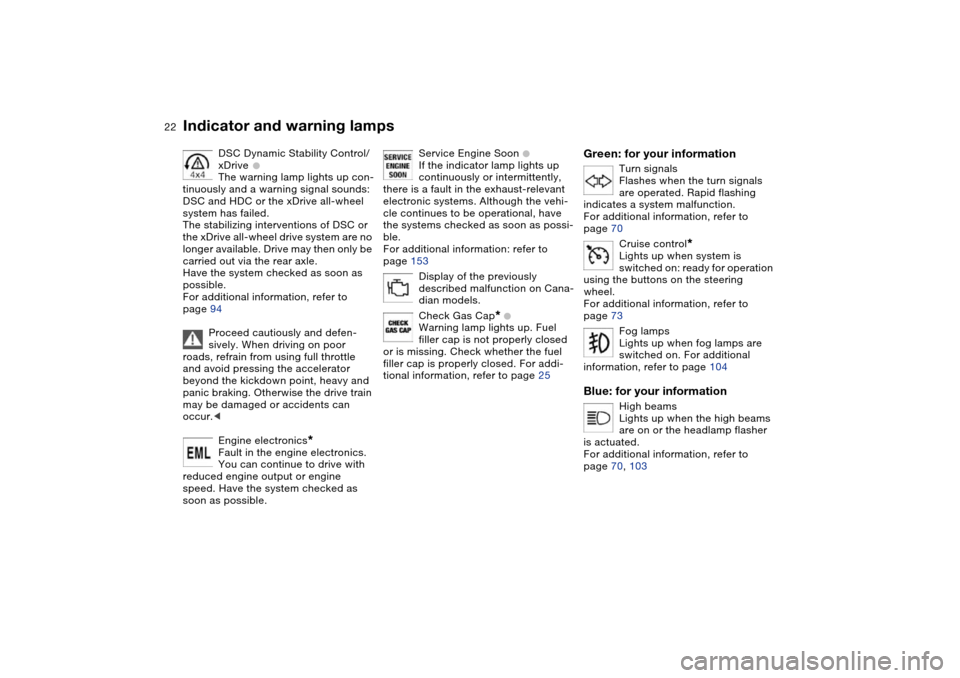
22n
Indicator and warning lamps
DSC Dynamic Stability Control/
xDrive
+
The warning lamp lights up con-
tinuously and a warning signal sounds:
DSC and HDC or the xDrive all-wheel
system has failed.
The stabilizing interventions of DSC or
the xDrive all-wheel drive system are no
longer available. Drive may then only be
carried out via the rear axle.
Have the system checked as soon as
possible.
For additional information, refer to
page 94
Proceed cautiously and defen-
sively. When driving on poor
roads, refrain from using full throttle
and avoid pressing the accelerator
beyond the kickdown point, heavy and
panic braking. Otherwise the drive train
may be damaged or accidents can
occur.<
Engine electronics
*
Fault in the engine electronics.
You can continue to drive with
reduced engine output or engine
speed. Have the system checked as
soon as possible.
Service Engine Soon
+
If the indicator lamp lights up
continuously or intermittently,
there is a fault in the exhaust-relevant
electronic systems. Although the vehi-
cle continues to be operational, have
the systems checked as soon as possi-
ble.
For additional information: refer to
page 153
Display of the previously
described malfunction on Cana-
dian models.
Check Gas Cap
* +
Warning lamp lights up. Fuel
filler cap is not properly closed
or is missing. Check whether the fuel
filler cap is properly closed. For addi-
tional information, refer to page 25
Green: for your information
Turn signals
Flashes when the turn signals
are operated. Rapid flashing
indicates a system malfunction.
For additional information, refer to
page 70
Cruise control
*
Lights up when system is
switched on: ready for operation
using the buttons on the steering
wheel.
For additional information, refer to
page 73
Fog lamps
Lights up when fog lamps are
switched on. For additional
information, refer to page 104
Blue: for your information
High beams
Lights up when the high beams
are on or the headlamp flasher
is actuated.
For additional information, refer to
page 70, 103
Page 25 of 200
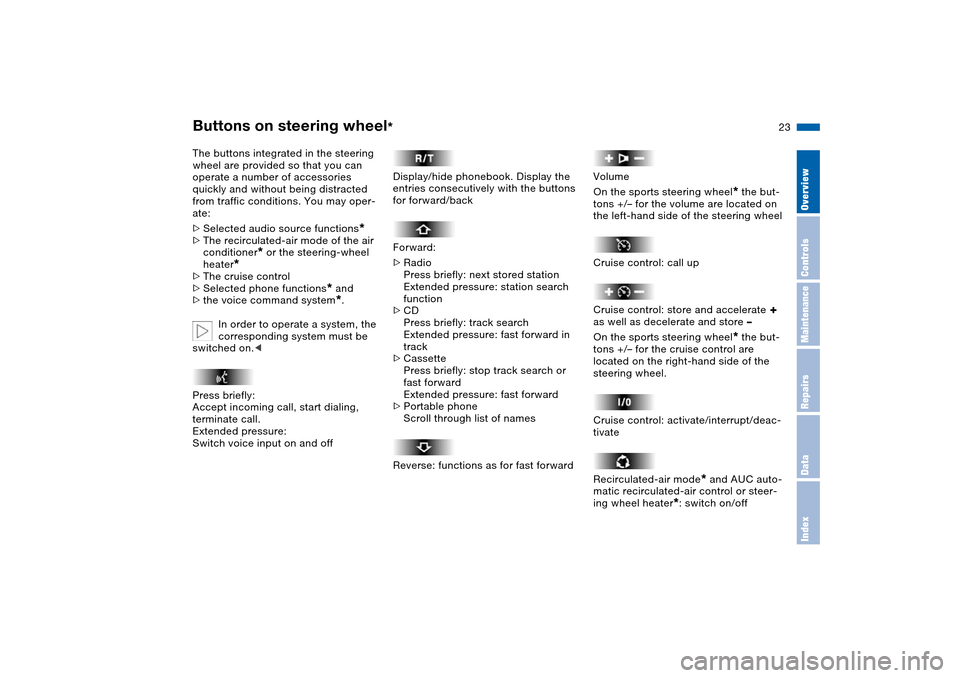
23n
OverviewControlsMaintenanceRepairsDataIndex
Buttons on steering wheel
*
The buttons integrated in the steering
wheel are provided so that you can
operate a number of accessories
quickly and without being distracted
from traffic conditions. You may oper-
ate:
>Selected audio source functions
*
>The recirculated-air mode of the air
conditioner
* or the steering-wheel
heater
*
>The cruise control
>Selected phone functions
* and
>the voice command system*.
In order to operate a system, the
corresponding system must be
switched on.<
Press briefly:
Accept incoming call, start dialing,
terminate call.
Extended pressure:
Switch voice input on and off
Display/hide phonebook. Display the
entries consecutively with the buttons
for forward/back
Forward:
>Radio
Press briefly: next stored station
Extended pressure: station search
function
>CD
Press briefly: track search
Extended pressure: fast forward in
track
>Cassette
Press briefly: stop track search or
fast forward
Extended pressure: fast forward
>Portable phone
Scroll through list of names
Reverse: functions as for fast forward
Volume
On the sports steering wheel
* the but-
tons +/– for the volume are located on
the left-hand side of the steering wheel
Cruise control: call up
Cruise control: store and accelerate
+
as well as decelerate and store –
On the sports steering wheel
* the but-
tons +/– for the cruise control are
located on the right-hand side of the
steering wheel.
Cruise control: activate/interrupt/deac-
tivate
Recirculated-air mode
* and AUC auto-
matic recirculated-air control or steer-
ing wheel heater
*: switch on/off
Page 26 of 200
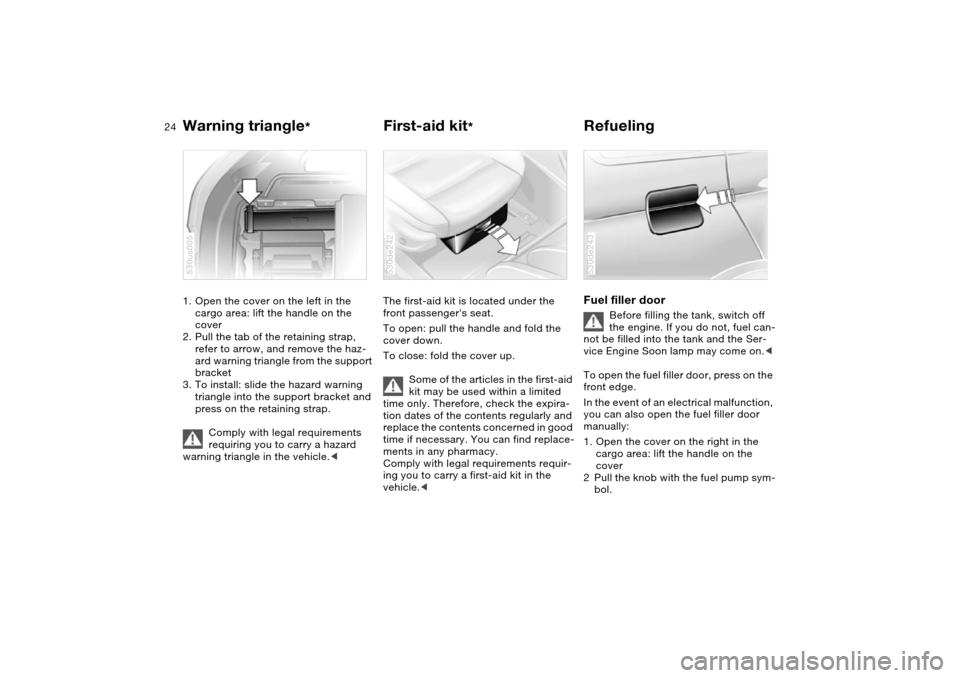
24n
Warning triangle
*
First-aid kit
*
Refueling
1. Open the cover on the left in the
cargo area: lift the handle on the
cover
2. Pull the tab of the retaining strap,
refer to arrow, and remove the haz-
ard warning triangle from the support
bracket
3. To install: slide the hazard warning
triangle into the support bracket and
press on the retaining strap.
Comply with legal requirements
requiring you to carry a hazard
warning triangle in the vehicle.< 530us005
The first-aid kit is located under the
front passenger's seat.
To open: pull the handle and fold the
cover down.
To close: fold the cover up.
Some of the articles in the first-aid
kit may be used within a limited
time only. Therefore, check the expira-
tion dates of the contents regularly and
replace the contents concerned in good
time if necessary. You can find replace-
ments in any pharmacy.
Comply with legal requirements requir-
ing you to carry a first-aid kit in the
vehicle.< 530de242
Fuel filler door
Before filling the tank, switch off
the engine. If you do not, fuel can-
not be filled into the tank and the Ser-
vice Engine Soon lamp may come on.<
To open the fuel filler door, press on the
front edge.
In the event of an electrical malfunction,
you can also open the fuel filler door
manually:
1. Open the cover on the right in the
cargo area: lift the handle on the
cover
2Pull the knob with the fuel pump sym-
bol.
530de243
Page 27 of 200
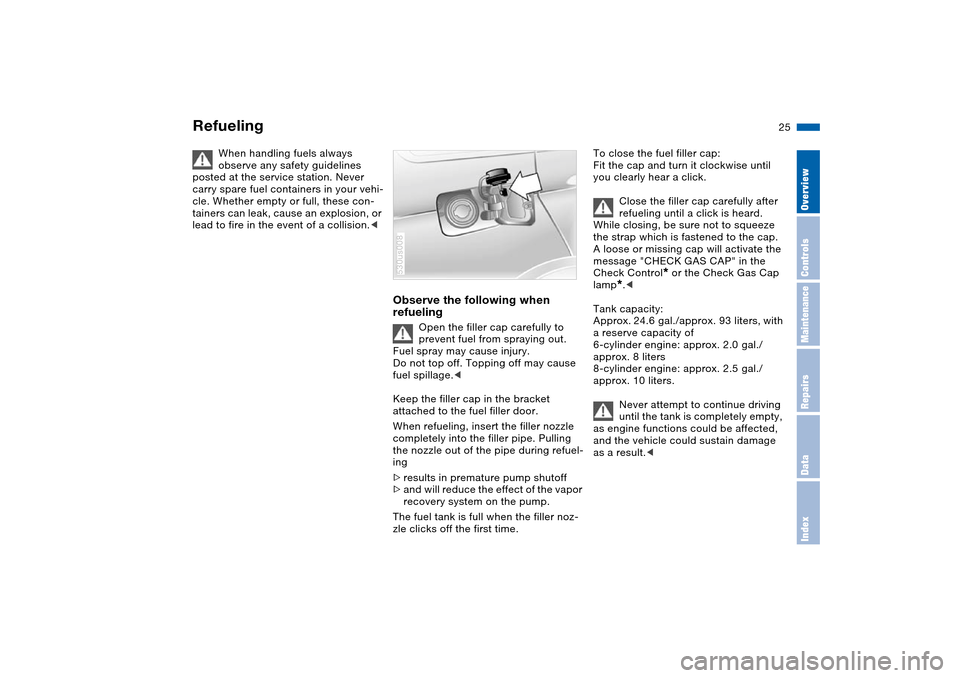
25n
OverviewControlsMaintenanceRepairsDataIndex
Refueling
When handling fuels always
observe any safety guidelines
posted at the service station. Never
carry spare fuel containers in your vehi-
cle. Whether empty or full, these con-
tainers can leak, cause an explosion, or
lead to fire in the event of a collision.<
Observe the following when
refueling
Open the filler cap carefully to
prevent fuel from spraying out.
Fuel spray may cause injury.
Do not top off. Topping off may cause
fuel spillage.<
Keep the filler cap in the bracket
attached to the fuel filler door.
When refueling, insert the filler nozzle
completely into the filler pipe. Pulling
the nozzle out of the pipe during refuel-
ing
>results in premature pump shutoff
>and will reduce the effect of the vapor
recovery system on the pump.
The fuel tank is full when the filler noz-
zle clicks off the first time.
530us008
To close the fuel filler cap:
Fit the cap and turn it clockwise until
you clearly hear a click.
Close the filler cap carefully after
refueling until a click is heard.
While closing, be sure not to squeeze
the strap which is fastened to the cap.
A loose or missing cap will activate the
message "CHECK GAS CAP" in the
Check Control
* or the Check Gas Cap
lamp
*.<
Tank capacity:
Approx. 24.6 gal./approx. 93 liters, with
a reserve capacity of
6-cylinder engine: approx. 2.0 gal./
approx. 8 liters
8-cylinder engine: approx. 2.5 gal./
approx. 10 liters.
Never attempt to continue driving
until the tank is completely empty,
as engine functions could be affected,
and the vehicle could sustain damage
as a result.<
Page 28 of 200

26n
Fuel specifications The engine uses lead-free gasoline
only.Required fuelPremium Unleaded Gasoline,
Minimum Octane Rating: 91.
Minimum Octane Rating corresponds
to the Anti Knock Index AKI and is
determined according to the so-called
(R+M)/2 method.
Do not use leaded gasoline, as
otherwise the lambda probe and
catalytic converter will be permanently
damaged.<
Use high-quality brandsField experience has indicated signifi-
cant differences in fuel quality: volatility,
composition, additives, etc., among
gasolines offered for sale in the United
States and Canada. Fuels containing up
to and including 10 % ethanol or other
oxygenates with up to 2.8 % oxygen by
weight, that is, 15 % MTBE or 3 % meth-
anol plus an equivalent amount of co-
solvent, will not void the applicable
warranties with respect to defects in
materials or workmanship.The use of poor-quality fuels may
result in drivability, starting and
stalling problems especially under cer-
tain environmental conditions such as
high ambient temperature and high alti-
tude.
Should you encounter drivability prob-
lems which you suspect could be
related to the fuel you are using, we
recommend that you respond by
switching to a recognized high-quality
brand.
Failure to comply with these recom-
mendations may also result in unsched-
uled maintenance.<
Page 29 of 200
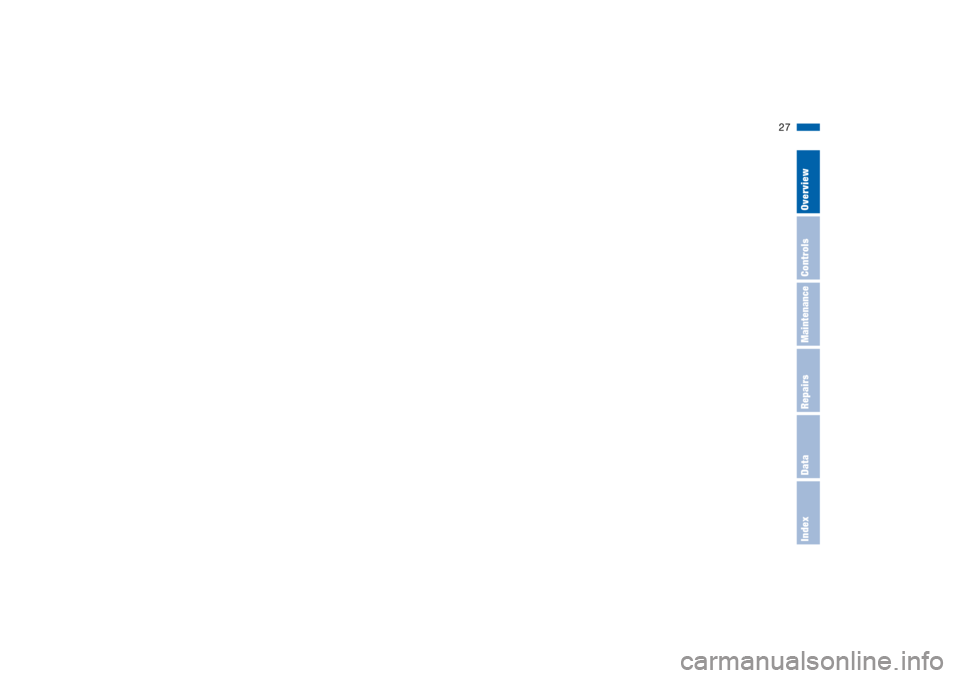
27n
OverviewControlsMaintenanceRepairsDataIndex
Page 30 of 200
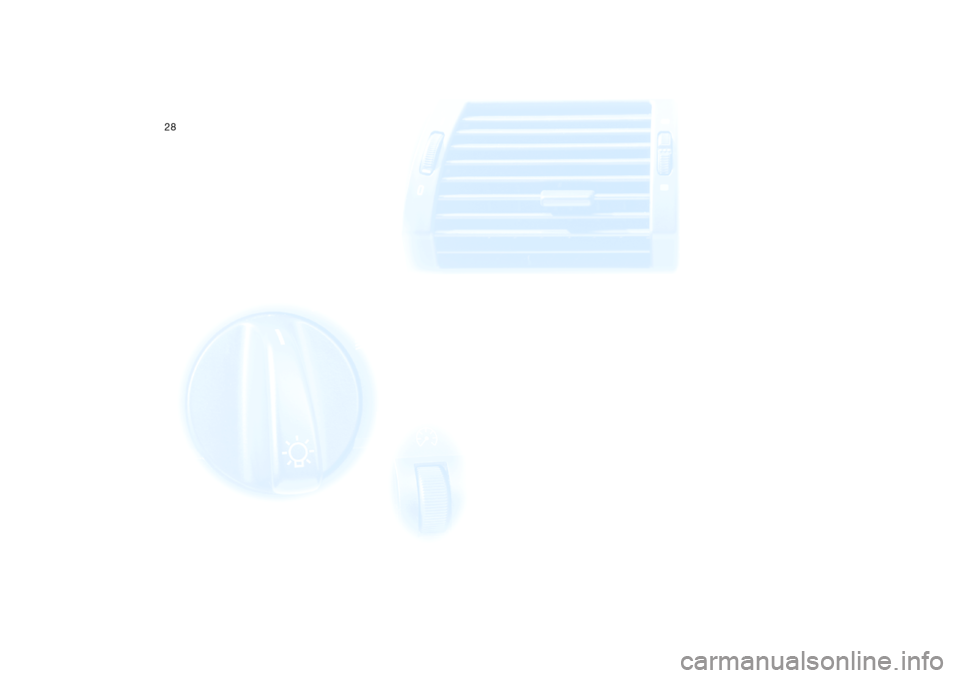
28n
Controls